Overview:
Achieving an A1C level of 6.0 is best accomplished through a combination of dietary changes, regular physical activity, medication adherence, blood sugar monitoring, and stress management. The article outlines specific strategies, such as adopting a balanced diet, engaging in at least 150 minutes of exercise weekly, and maintaining open communication with healthcare providers, emphasizing that these practices collectively support effective diabetes management and reduce the risk of complications.
Introduction
Understanding and managing A1C levels is a critical aspect of diabetes care that can significantly influence health outcomes. The A1C test, which measures average blood sugar levels over the past two to three months, serves as a key indicator for both patients and healthcare providers in assessing diabetes management.
With an alarming rise in diabetes prevalence and the associated economic burden, it is essential for individuals to engage actively in their health management strategies. This article explores effective methods for achieving optimal A1C levels, emphasizing the importance of:
- Dietary choices
- Physical activity
- Medication adherence
- Regular monitoring
By leveraging comprehensive resources and support, individuals can take proactive steps towards better diabetes control and improved overall health.
Understanding A1C: What It Means for Diabetes Management
As T2DSolutions gets ready to launch as a complete resource for Type 2 and Type 3 blood sugar education and community support, it is crucial to grasp the significance of the A1C test in health oversight. The A1C test acts as a vital sign of average blood sugar readings over the prior two to three months, offering both patients and healthcare providers with essential insights into diabetes management. An A1C measurement of a1c at 6.0% indicates effective blood glucose control, substantially reducing the likelihood of developing diabetes-related complications.
For context, an A1C at 6.0 corresponds to an average blood glucose concentration of approximately 126 mg/dL, illustrating its direct relevance to daily monitoring practices. It is imperative that patients engage in regular discussions regarding their A1C results with their healthcare team. Such dialogues can illuminate how various factors—including lifestyle choices, adherence to prescribed medications, and stress management—affect A1C values.
T2DSolutions will provide educational materials, tools, and community assistance programs to help patients comprehend their A1C values and create effective control strategies. Recent studies have emphasized the importance of sustaining optimal A1C figures, as only 11.1% of adults satisfied all criteria for A1C, blood pressure, cholesterol, and smoking, highlighting the substantial difficulties in attaining thorough control of blood sugar conditions. This statistic is especially alarming considering that the median county-level occurrence of diagnosed health condition has increased from 6.3% in 2004 to 8.3% in 2021, emphasizing the necessity for effective control strategies.
Moreover, the economic burdens of this condition in the U.S., as highlighted by Parker ED, stress the financial consequences of inadequate management, reinforcing the significance of upholding optimal A1C values. As highlighted in the State of Healthcare Quality Report, understanding these dynamics is vital for effective diabetes control and minimizing the risk of complications.
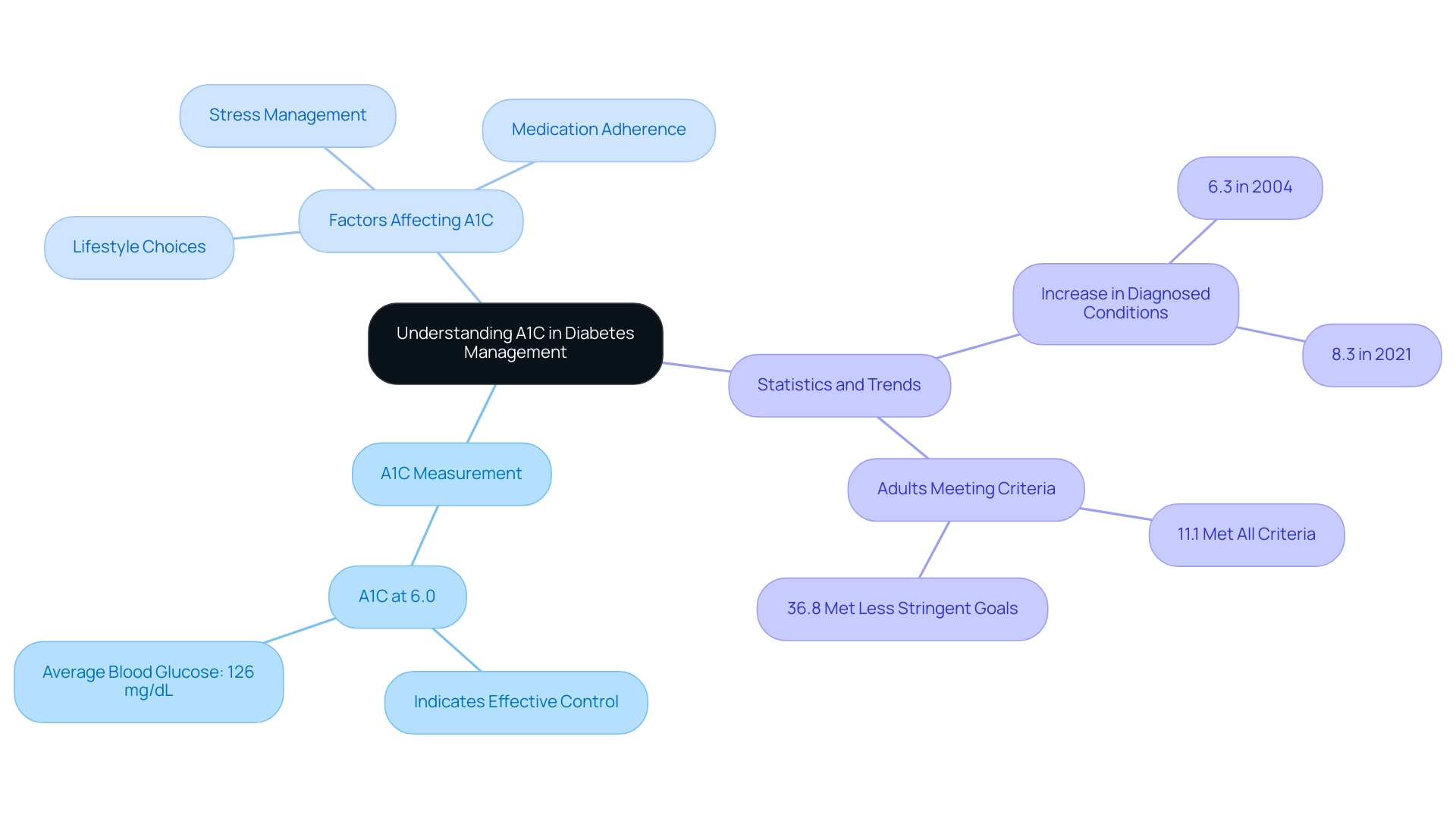
Effective Strategies for Lowering A1C Levels to 6.0
To achieve a target A1C number of 6.0, individuals should implement several key strategies, supported by the resources available at T2DSolutions:
-
Dietary Changes: Adopting a balanced diet is essential. Focus on incorporating whole grains, lean proteins, healthy fats, and a variety of fruits and vegetables. Carbohydrate counting is a valuable tool; aim to limit refined sugars and carefully monitor portion sizes. Recent studies have indicated that specific dietary patterns, such as the Mediterranean and plant-based diets, can significantly enhance glycemic control and reduce HbA1c values. A study involving 1,150 participants (769 women and 381 men) demonstrated the effectiveness of these dietary changes in managing A1C at 6.0. T2DSolutions offers tailored nutritional guidance, including personalized meal plans and access to dietitian consultations, to help individuals make informed dietary choices.
-
Regular Physical Activity: Engaging in at least 150 minutes of moderate aerobic activity weekly—activities like walking, cycling, or swimming—can greatly enhance insulin sensitivity. Additionally, integrating strength training exercises at least twice a week has shown positive effects on A1C levels. Notably, recent findings indicate that physical activity can lead to substantial improvements in diabetes management, achieving an A1C at 6.0 among individuals with diabetes. T2DSolutions provides community support through exercise groups and fitness challenges to encourage active lifestyles.
-
Medication Adherence: It is vital to follow prescribed medication regimens, including insulin, if necessary. Consistent usage as directed, along with regular consultations with healthcare providers, ensures that medication effectiveness is monitored and adjusted as needed. At T2DSolutions, patients can find information on medication management, including reminders and tracking tools, and connect with healthcare professionals for guidance.
-
Monitoring Blood Sugar: Regular self-assessment of blood glucose is essential for understanding how different factors—such as diet, activity intensity, and stress—impact blood sugar. Keeping a detailed log can help identify patterns, making it easier to adjust dietary and lifestyle choices accordingly. T2DSolutions encourages patients to utilize tracking tools and offers a mobile app for easy logging and insights into their health data.
-
Stress Management: Implementing stress-reduction techniques such as mindfulness, yoga, and meditation can have a positive effect on blood sugar readings. Engaging in enjoyable and relaxing activities also contributes to overall mental well-being. T2DSolutions provides resources and community support for stress management techniques, including workshops and online forums for sharing experiences.
By diligently applying these strategies, individuals can work towards achieving an A1C at 6.0, thereby enhancing their overall health management. The significance of tailored nutritional strategies cannot be overstated, as they enable patients to take charge of their health while addressing social factors that may impact self-care. As Dr. Lydia A. Bazzano pointed out, the ongoing research funded by the National Institutes of Health emphasizes the essential role of customized dietary modifications in enhancing health results for individuals with blood sugar issues, a mission that T2 Solutions is dedicated to supporting.
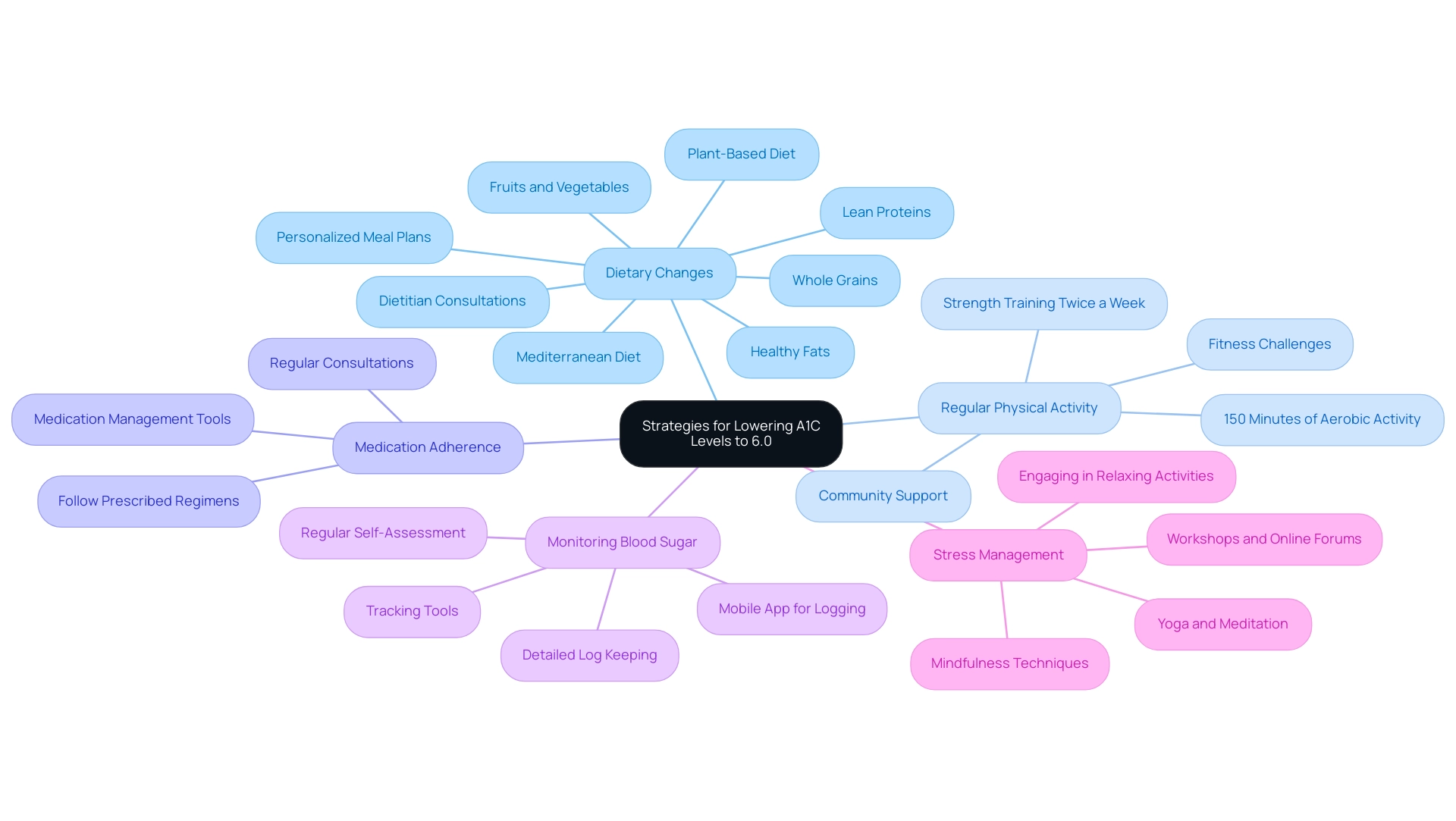
The Role of Nutrition in Achieving A1C Goals
A well-balanced diet is essential for effective management of blood sugar. Key nutritional strategies to consider include:
-
Focus on Low Glycemic Index Foods: Prioritizing foods with a low glycemic index (GI) is critical, as these foods produce gradual increases in blood sugar levels.
Incorporate options such as whole grains, legumes, non-starchy vegetables, and a variety of fruits into daily meals. Research has shown that adopting a Mediterranean-style diet, rich in monounsaturated fatty acids (MUFA), can significantly benefit glycemic control and cardiovascular health in individuals with type 2 diabetes. As noted, a Mediterranean-style, MUFA-rich eating pattern is recommended as an effective alternative to lower-fat, higher-carbohydrate diets. -
Portion Control: Mastery of portion sizes is vital for preventing overeating, a common challenge that can lead to spikes in blood sugar.
Utilizing measuring cups or food scales can provide accurate assessments of portion sizes, promoting better management of caloric intake.
Real-world examples demonstrate how effective portion control can lead to improved A1C readings, potentially reaching an A1C at 6.0 over time. Additionally, adhering to dietary fat and cholesterol goals can further enhance glycemic control and cardiovascular risk factors. -
Regular Meal Timing: Consistency in meal timing plays a crucial role in regulating blood sugar concentrations.
Skipping meals may result in excessive hunger and subsequent overeating, negatively affecting A1C outcomes. Establishing a regular eating schedule can help maintain stable blood sugar rates throughout the day. -
Hydration: Adequate hydration is fundamental to health.
It is essential to drink plenty of water throughout the day while limiting the intake of sugary beverages that can lead to spikes in blood sugar.
Studies indicate that substituting sugar-sweetened drinks with water can lower the risk of developing type 2 conditions by 7-8%. -
Consulting a Registered Dietitian: Partnering with a registered dietitian can empower individuals to create customized meal plans that help them reach an A1C at 6.0.
Dietitians provide essential instruction on carbohydrate counting, mindful eating methods, and effective techniques for reducing A1C values, enabling a more customized approach to managing the condition.
For more resources and support, consider subscribing to T D Solutions, where you can find additional information and community support tailored for newly diagnosed patients.
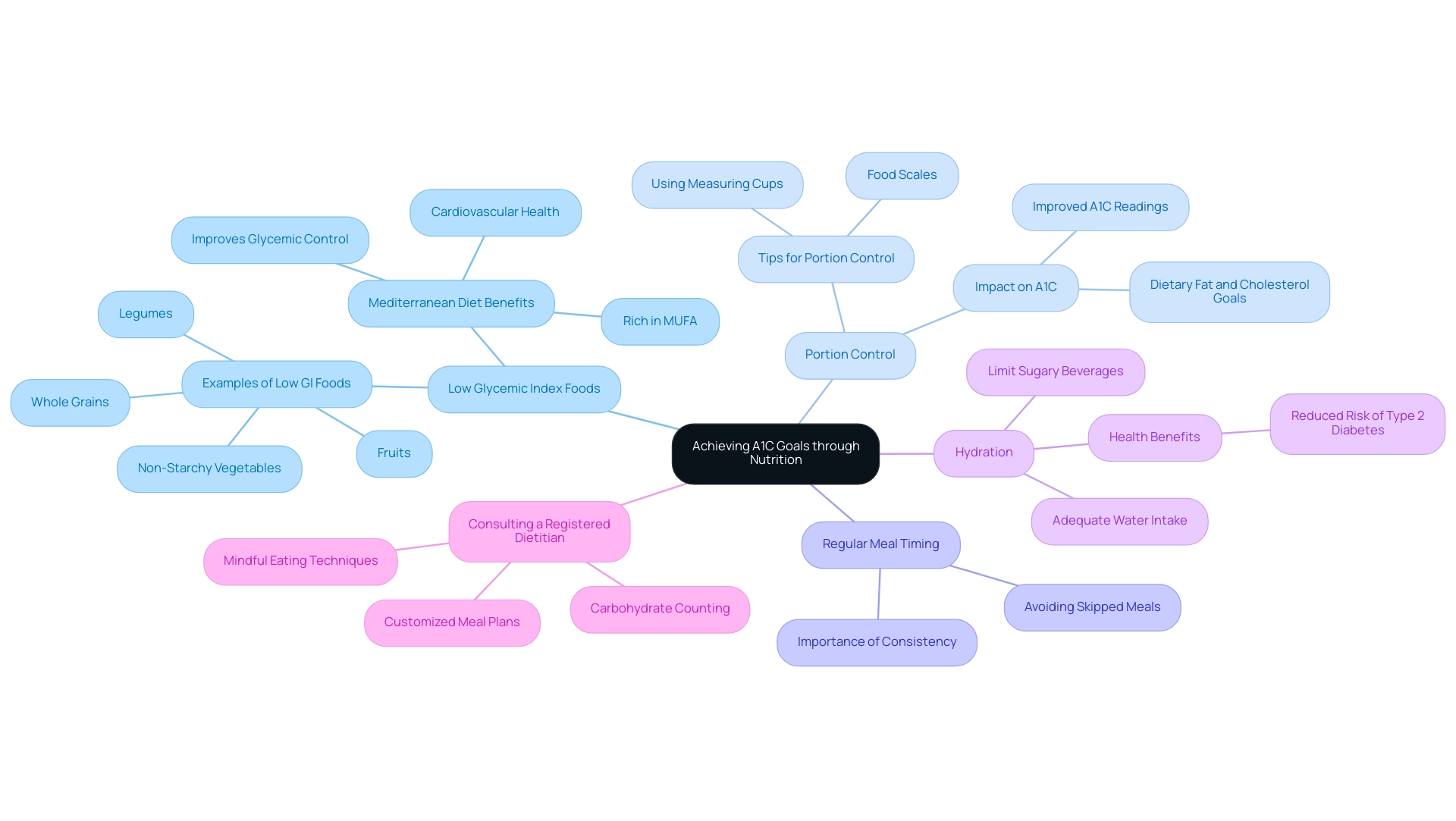
Incorporating Physical Activity into Your Routine
Incorporating regular physical activity into daily routines is crucial for effectively lowering A1C to A1C at 6.0 levels. The latest guidelines for 2024 emphasize several key strategies:
- Set Realistic Goals: Begin with achievable targets, such as 10-15 minutes of activity each day, gradually increasing both the duration and intensity over time.
- Choose Enjoyable Activities: Engaging in physical activities that bring joy—whether it’s dancing, walking with friends, or participating in a sport—can significantly enhance adherence to exercise routines. Research indicates that enjoyment is a critical factor in maintaining long-term physical activity habits.
- Mix Cardio and Strength Training: Aim for a balanced regimen that includes both aerobic exercises like brisk walking or cycling, and strength training utilizing weights or resistance bands. This combination has been demonstrated to enhance insulin sensitivity, a crucial element in the control of blood sugar. As emphasized in the case study titled "Conclusions on Physical Activity for T2D Control," various types of physical activity, including flexibility and balance exercises, can significantly enhance health and glycemic regulation in individuals with T2D.
- Incorporate Movement into Daily Life: Identify opportunities for increased activity throughout the day, such as opting for stairs instead of elevators or taking short walks during breaks. This approach not only aids in achieving fitness goals but also integrates physical activity seamlessly into daily living.
- Monitor Blood Sugar Before and After Exercise: Understanding how different workouts affect blood sugar levels is crucial for effective health control. Keeping snacks accessible can help mitigate unexpected drops in blood sugar during or after physical activity. Additionally, in the absence of a stress test measured maximal heart rate, using the Rating of Perceived Exertion (RPE) scale (10 to 12 on a 6-20 scale) can serve as a practical tool for assessing exercise intensity.
These practices align with current trends, which reveal that participants engaged in regular physical activity are more likely to maintain a healthy food score, particularly among women, where studies show an odds ratio of 1.77. Overall, incorporating physical activity not only enhances A1C management but also contributes to improved overall health, helping individuals achieve an A1C at 6.0. As researchers state, "Our findings support clinical practice guideline recommendations for aerobic and combined exercise prescriptions," reinforcing the importance of these strategies.
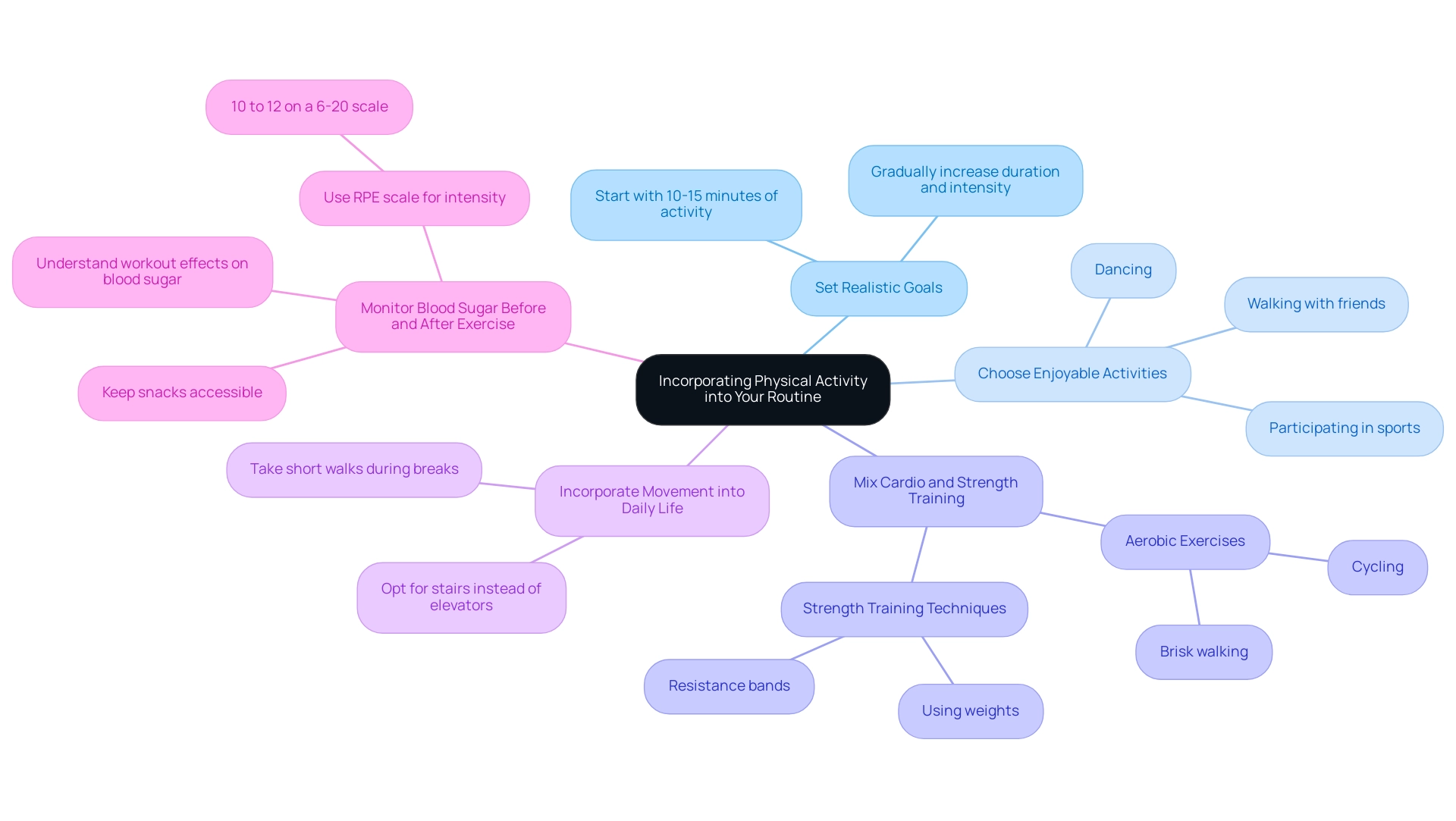
The Importance of Regular Monitoring and Follow-Up
To effectively manage the condition and work towards an A1C at 6.0, individuals should prioritize regular monitoring and follow-ups. T2DSolutions is committed to providing comprehensive resources to support newly diagnosed patients in this journey:
- Regular A1C Testing: Schedule routine A1C tests as recommended by healthcare providers to assess long-term blood sugar control.
The 2024 recommendations stress the importance of this practice, with a clear emphasis on how it informs treatment adjustments. T2DSolutions will offer easy access to testing resources and guidelines to help individuals stay on track.
- Self-Monitoring Blood Glucose (SMBG): Daily monitoring of blood glucose levels is essential.
This practice allows individuals to recognize patterns that inform decisions regarding diet, exercise, and medication. T2DSolutions will offer tools and resources to streamline SMBG, ensuring effective control of blood sugar levels. Recent statistics have indicated that effective SMBG can result in enhanced glycemic control and better oversight of the condition overall.
- Communicate with Healthcare Providers: Maintaining open lines of communication with healthcare providers is crucial.
Discussing results and challenges ensures that treatment plans are tailored to individual needs. T2DSolutions will facilitate connections with healthcare professionals through its platform, enhancing communication and support.
- Join Diabetes Education Programs: Taking part in continuous education regarding blood sugar conditions assists individuals in remaining knowledgeable about the newest control techniques and technologies.
T2DSolutions will offer a variety of educational resources and programs that enhance self-management skills and improve health outcomes.
- Set Goals and Track Progress: Collaborate with healthcare professionals to establish realistic and achievable goals while tracking progress regularly.
T2DSolutions will provide goal-setting tools and progress tracking features to foster motivation and aid in maintaining focus on achieving A1C at 6.0. The case study on Cystic Fibrosis-Related Diabetes (CFRD) emphasizes that personalized care, including regular monitoring and insulin treatment to reach tailored glycemic targets, is essential for attaining optimal health results. Annual monitoring for complications of the condition is also recommended starting five years after the diagnosis of CFRD.
With T2D Solutions launching soon, patients can look forward to these supportive features that will empower them in their diabetes management journey.
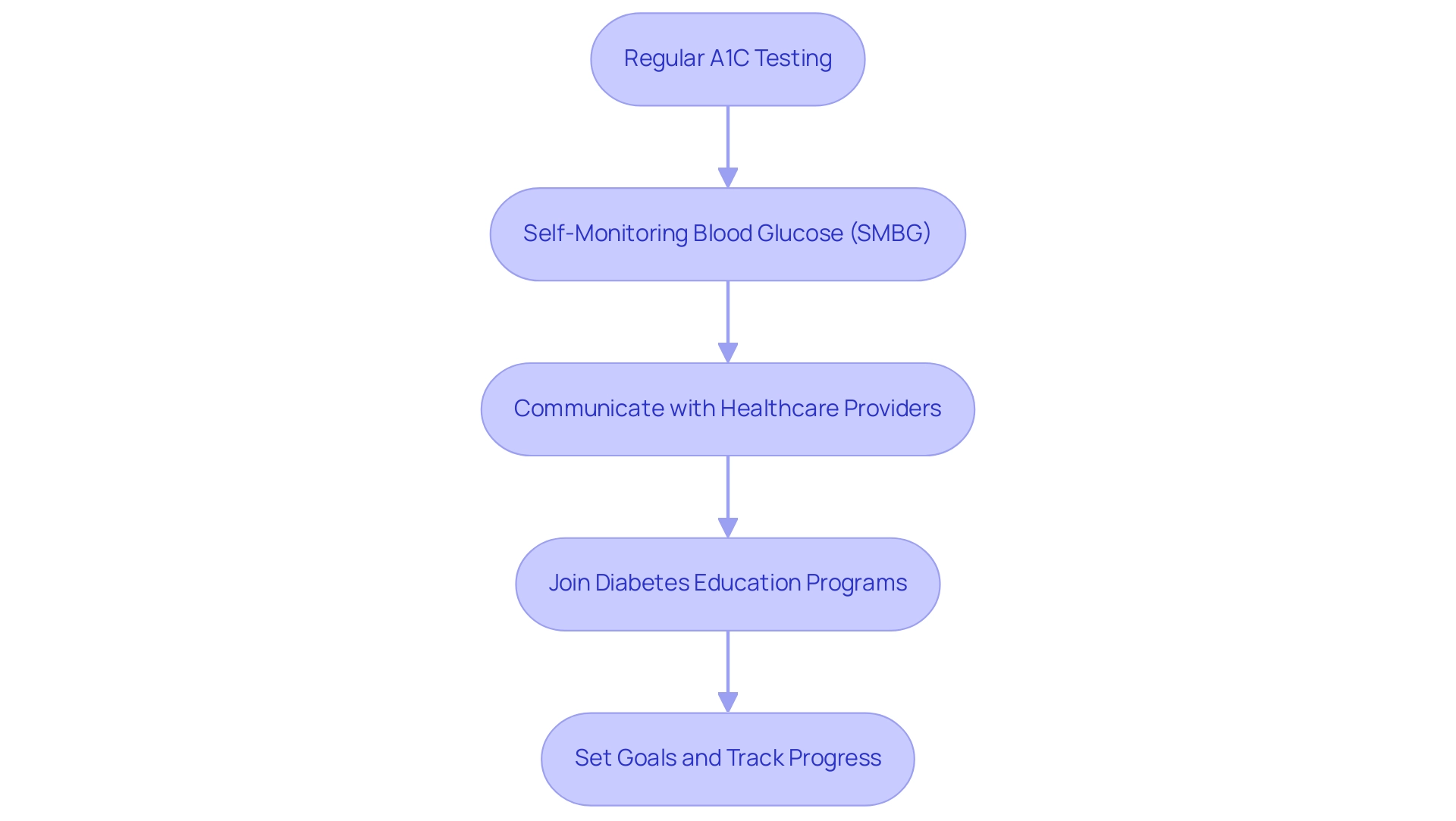
Conclusion
Achieving and maintaining optimal A1C levels is paramount for effective diabetes management and overall health. The A1C test provides vital insights into average blood sugar levels, guiding both patients and healthcare providers in making informed decisions. By targeting an A1C level of 6.0%, individuals can significantly reduce the risk of complications associated with diabetes.
Implementing strategies such as:
- Dietary modifications
- Regular physical activity
- Medication adherence
- Consistent monitoring
can lead to substantial improvements in A1C levels. Emphasizing a balanced diet rich in low glycemic index foods, engaging in enjoyable physical activities, and maintaining open communication with healthcare professionals are critical components of a successful diabetes management plan.
As the prevalence of diabetes continues to rise, the importance of proactive health management cannot be overstated. Leveraging resources like T2DSolutions can empower individuals to take control of their health, equipping them with the knowledge and support necessary for effective diabetes care. By committing to these strategies, individuals can not only achieve their A1C goals but also enhance their overall quality of life, paving the way for better health outcomes.



